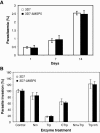A set of glycosylphosphatidyl inositol-anchored membrane proteins of Plasmodium falciparum is refractory to genetic deletion
- PMID: 16790807
- PMCID: PMC1489731
- DOI: 10.1128/IAI.00054-06
A set of glycosylphosphatidyl inositol-anchored membrane proteins of Plasmodium falciparum is refractory to genetic deletion
Abstract
Targeted gene disruption has proved to be a powerful approach for studying the function of important ligands involved in erythrocyte invasion by the extracellular merozoite form of the human malaria parasite, Plasmodium falciparum. Merozoite invasion proceeds via a number of seemingly independent alternate pathways, such that entry can proceed with parasites lacking particular ligand-receptor interactions. To date, most focus in this regard has been on single-pass (type 1) membrane proteins that reside in the secretory organelles. Another class of merozoite proteins likely to include ligands for erythrocyte receptors are the glycosylphosphatidyl inositol (GPI)-anchored membrane proteins that coat the parasite surface and/or reside in the apical organelles. Several of these are prominent vaccine candidates, although their functions remain unknown. Here, we systematically attempted to disrupt the genes encoding seven of the known GPI-anchored merozoite proteins of P. falciparum by using a double-crossover gene-targeting approach. Surprisingly, and in apparent contrast to other merozoite antigen classes, most of the genes (six of seven) encoding GPI-anchored merozoite proteins are refractory to genetic deletion, with the exception being the gene encoding merozoite surface protein 5 (MSP-5). No distinguishable growth rate or invasion pathway phenotype was detected for the msp-5 knockout line, although its presence as a surface-localized protein was confirmed.
Figures






Similar articles
-
The Plasmodium vivax homologues of merozoite surface proteins 4 and 5 from Plasmodium falciparum are expressed at different locations in the merozoite.Mol Biochem Parasitol. 2002 Apr 9;120(2):215-24. doi: 10.1016/s0166-6851(01)00458-3. Mol Biochem Parasitol. 2002. PMID: 11897127
-
Distinct protein classes including novel merozoite surface antigens in Raft-like membranes of Plasmodium falciparum.J Biol Chem. 2005 Dec 2;280(48):40169-76. doi: 10.1074/jbc.M509631200. Epub 2005 Oct 3. J Biol Chem. 2005. PMID: 16203726
-
Deletion of the Plasmodium falciparum merozoite surface protein 7 gene impairs parasite invasion of erythrocytes.Eukaryot Cell. 2008 Dec;7(12):2123-32. doi: 10.1128/EC.00274-08. Epub 2008 Sep 26. Eukaryot Cell. 2008. PMID: 18820076 Free PMC article.
-
Natural selection on apical membrane antigen-1 of Plasmodium falciparum.Parassitologia. 1999 Sep;41(1-3):93-5. Parassitologia. 1999. PMID: 10697839 Review.
-
Genetic polymorphism in Plasmodium falciparum vaccine candidate antigens.Indian J Pathol Microbiol. 2005 Oct;48(4):429-38. Indian J Pathol Microbiol. 2005. PMID: 16366089 Review.
Cited by
-
The disruption of GDP-fucose de novo biosynthesis suggests the presence of a novel fucose-containing glycoconjugate in Plasmodium asexual blood stages.Sci Rep. 2016 Nov 16;6:37230. doi: 10.1038/srep37230. Sci Rep. 2016. PMID: 27849032 Free PMC article.
-
Merozoite surface proteins in red blood cell invasion, immunity and vaccines against malaria.FEMS Microbiol Rev. 2016 May;40(3):343-72. doi: 10.1093/femsre/fuw001. Epub 2016 Jan 31. FEMS Microbiol Rev. 2016. PMID: 26833236 Free PMC article. Review.
-
Plasmodium falciparum Pf34, a novel GPI-anchored rhoptry protein found in detergent-resistant microdomains.Int J Parasitol. 2007 Sep;37(11):1233-41. doi: 10.1016/j.ijpara.2007.03.013. Epub 2007 Apr 19. Int J Parasitol. 2007. PMID: 17521656 Free PMC article.
-
Central carbon metabolism of Plasmodium parasites.Mol Biochem Parasitol. 2011 Feb;175(2):95-103. doi: 10.1016/j.molbiopara.2010.09.001. Epub 2010 Sep 16. Mol Biochem Parasitol. 2011. PMID: 20849882 Free PMC article. Review.
-
Hexosamine biosynthesis disruption impairs GPI production and arrests Plasmodium falciparum growth at schizont stages.PLoS Pathog. 2025 Jul 3;21(7):e1012832. doi: 10.1371/journal.ppat.1012832. eCollection 2025 Jul. PLoS Pathog. 2025. PMID: 40608817 Free PMC article.
References
-
- Bannister, L. H., G. H. Mitchell, G. A. Butcher, E. D. Dennis, and S. Cohen. 1986. Structure and development of the surface coat of erythrocytic merozoites of Plasmodium knowlesi. Cell Tissue Res. 245:281-290. - PubMed
-
- Benet, A., L. Tavul, J. C. Reeder, and A. Cortes. 2004. Diversity of Plasmodium falciparum vaccine candidate merozoite surface protein 4 (MSP4) in a natural population. Mol. Biochem. Parasitol. 134:275-280. - PubMed
Publication types
MeSH terms
Substances
Grants and funding
LinkOut - more resources
Full Text Sources
Research Materials

